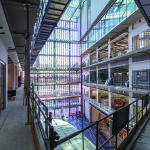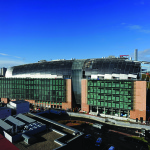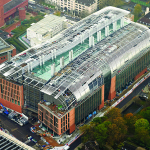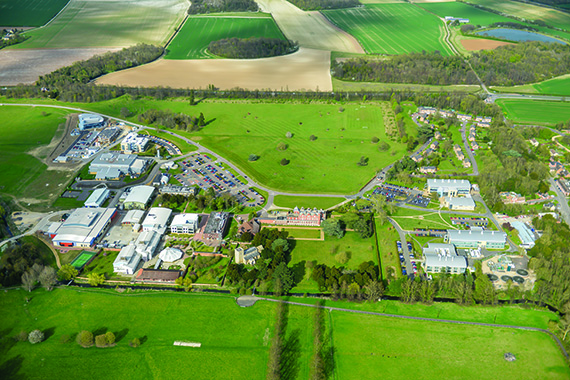David Lupson has been searching for lab space for a 100-person biotech company, well-funded and long-established, between the northern edge of London and the southern fringe of Cambridge to no avail.
Even with a fairly broad target area bestriding the UK’s life sciences heartland – “anywhere along the M11” – the director of Savills Science has found next to nothing so far in his three-week search.
“There are a small number of suboptimal opportunities,” says Lupson grudgingly. “But none are immediately fit for purpose.”
Several landlords have offered to build a bespoke facility, but that would take two years and this company wants to move in January. And the funders or owners of companies like these are generally not prepared to make any capital expenditure. They want as many costs as possible rentalised – who knows when or if a company will strike gold, or if its technology will fail completely?
This is the challenge for small and medium enterprises in the UK life sciences sector. They are the lifeblood of a £50bn industry that employs 165,000 people, but a shortage of suitable lab space is holding them back. Agents who work in the small, highly specialised labs sector are divided on whether there is an overall shortage across the UK, but everyone agrees that spaces for smaller firms are in short supply.
The two greatest areas of need are incubator spaces for start-ups and, even more critically, grow-on spaces for those who’ve made it to the next level and are seeking to expand.
“There is a lot of lab space around but it’s not optimised for the part of the market where there’s demand,” says Lupson. “It might provide larger floorplates than companies need or have aged air handling systems. Just because a former pharma R&D centre met the needs of that organisation, it doesn’t necessarily mean that space is appropriate for SMEs.”
World leaders
This is not just an issue for the minnows of the biotech sector – it is potentially a problem for UK plc. The government wants the UK to become the global hub for life sciences, a sprawling £868bn mega-sector spanning pharmaceuticals, medical technology and biotechnology and encompassing everything from hospital equipment and prosthetic limbs to drug development and gene therapy.
The UK is already a world leader, accounting for 6% of the global market and receiving one-third of all foreign investment into life sciences in Europe. Next year, the continent’s largest biomedical research centre will open in London at King’s Cross. The Francis Crick Institute will house 1,500 researchers in almost 1m sq ft of state-of-the-art space. “That’s absolutely enormous, a massive concentration of global talent,” says Dr Stephen King, deputy director of the London-Stansted-Cambridge Consortium, which promotes the area’s economic development. “That will supercharge the London-Stansted-Cambridge corridor.”
But there’s still so much untapped potential: London is second only to Boston in the volume of biomedical research undertaken but receives a mere tenth of comparable inward investment, according to figures from the mayor of London’s MedCity initiative.
Capacity is part of the problem, says Sarah Tasker, director of science park specialist CAM-SCI. She says: “London’s research excellence is fuelling this massive global industry but it’s not able to capture the commercial value. London is a magnet for companies to co-locate but there’s a lack of specialist infrastructure for this sector. As a country, we are struggling to meet demand for space, even the demand we’re generating internally.”
There is 8.2m sq ft of commercial lab space in the greater Boston area, she points out, 5.8m sq ft in San Francisco and 15m sq ft in San Diego. London has just 80,000 sq ft. Even Cambridge, the UK’s leading hub for life sciences, has only 1.4m sq ft.
To look at it another way, the growth of life sciences in the UK could present a considerable opportunity for the property sector, if it can find a way to reconcile the dynamism of the sector with the certainty required by investors. Laboratories are expensive to build and highly specialised for different fields – “more akin to machines than buildings,” says Tasker – but corporate lifecycles are short and unpredictable. Firms may swell exponentially when their eureka moment arrives, or disband overnight if it turns into a dead end.
“Lots of early-stage life sciences companies come out of the universities and grow very quickly,” says David Williams, partner at Bidwells in Oxford which, with London and Cambridge, is the third point of the UK’s ‘golden triangle’ for research. “They typically have immediate and short-term requirements linked to funding cycles, so the conventional offer of a shell building available for a three-to-five year term doesn’t fit their requirements. Property offerings have to give that flexibility.”Open innovation
What is certain is that the diversity of the life sciences sector is here to stay as Big Pharma downsizes, consolidates and outsources an increasing proportion of R&D work to smaller firms.
Before the global financial crisis, the world’s pharma giants were locked in a battle for scale and breadth. They have since been selling off non-core divisions and bracing themselves for the impact of the “patent cliff” – a bulge in the expiry dates of their exclusive drug licences, which has put pressure on revenues.
“Companies have all realised they have to be more efficient,” says Neil Gorman, who leads the EMEA life sciences sector group at Cushman & Wakefield. “The cost of drug development is huge and there has been a relatively low-growth business environment. Despite the opportunities in emerging economies, these firms still face a challenge on getting a return for the vast amount of money spent on R&D.”
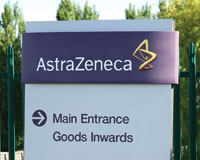
In the UK, this has manifested itself in a mass shedding of jobs and space over recent years. AstraZeneca’s move to Cambridge in 2016 will see it close both its London headquarters and giant Alderley Edge R&D centre in Cheshire, while Pfizer closed its vast Sandwich campus in Kent in 2011, leaving 3m sq ft of buildings. The biggest companies are now pursuing an approach known as “open innovation” on campuses with a mix of large and small, public and private organisations.
Stevenage Bioscience Catalyst is a joint venture between GlaxoSmithKline and the Wellcome Trust, described as “the UK’s first open innovation biomedical catalyst”. The 25-acre site is co-located with the GSK campus and currently provides incubator space for 40 start-ups. “If you just have start-ups paying start-up rents, it’s hard to make these buildings stack up,” says Miranda Knaggs, sales, marketing and events manager at SBC. “We’ve been very fortunate in that our stakeholders only want us to break even and they’ve given us a longer time frame to do that.”
Cost is a paramount concern for young firms, says Dr Claire Thompson, founder of Stevenage tenant Agility Health Tech. “Beyond that, the concerns are, what do the modules look like, can they be adapted in the future, will firms be able to grow within that facility? Proximity to clients is also a big draw.”
This is increasing an already pronounced clustering effect. “If you were a research organisation in Manchester 25 years ago, you’d have stayed there and visited Harwell to use its facilities,” says Duncan Quig, director of life sciences agency at Lambert Smith Hampton in Cambridge. “Now it’s much more likely that companies will move to a particular location to surround themselves with people working in the same field.” Universities too are leaving their ivory towers – both Cambridge and UCL have a presence on the Stevenage site, for example.
Regional specialists
A successful life sciences development must include a university or research institute, a major corporate occupier or a hospital – but ideally all three. Cambridge has the greatest critical mass, but around the UK, other places are competing to attract particular branches of the life sciences with academic tie-ins and investment in state-of-the-art facilities and equipment.
Norwich is the established home of food technology and crop science, while Exeter has set its sights on Big Data, with the Met Office’s investment in a £97m supercomputer. Birmingham is seeking to develop its medical speciality in the area around a major new hospital and its university (see Sir Albert Bore interview, p44).
“This is not a sector or set of sectors that will spread anywhere across the UK,” agrees Martyn Saunders, associate director at Bilfinger GVA. “While the potential for UK plc is very strong, for the UK geographically it’s a mixed picture.”
Saunders is one of the authors of a report published by the London Stansted Cambridge Consortium in April, which predicts that at least 14,000 new life sciences jobs would be created in this corridor by 2023, in addition to the 40,400 already there. Now they just need to persuade the firms flocking to the area that they don’t necessary need a Cambridge postcode to reap the benefits of co-location. Saunders says: “The challenge is that the capacity isn’t necessary where those in the industry would want it. It’s difficult to get them to understand that Harlow is only 15, 20 minutes away.”
This is a conversation that Andrew Bramidge has been having regularly, as project director of Harlow Enterprise Zone, just down the M11. The local authority has earmarked a 35-acre greenfield site for the creation of a new science park, to draw high-level jobs to the area and capitalise on the overheated Cambridge market. Selection of a development partner is underway, with construction intended to start in the second half of 2016.
“We don’t expect to compete with Cambridge – companies that want to be there will pay whatever it takes,” says Bramidge. “But there are other companies that want proximity to larger businesses but don’t want to pay to be physically co-located.” He has already had a conversation with AstraZeneca about providing accommodation for its supply chain from 2016.
Campus atmosphere
Aside from location and the all-important academic tie-up – Anglia Ruskin University is to establish a medtech innovation centre there – Bramidge hopes to lure occupiers with a mix of flexible spaces and a campus atmosphere.
“Flexibility is an absolutely key factor because industry changes all the time, so that means we will need buildings that can be expanded and walls that can be taken down. And we will have some restaurants and cafés, places people can meet or interact. People are interested in collaboration and sharing ideas and we want to facilitate that through the physical design of the park,” says Bramidge.
It is this blend of activities and amenities that sets a true science park apart from a business park with a scientific bent.
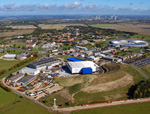
Harwell campus in Oxfordshire has a range of specialist technology including the UK’s synchrotron – a giant particle accelerator used in fields as diverse as medical research and mineral exploration – and is the home of the UK Space Agency. Its owners are seeking to position it as a place where scientists in different fields can exchange ideas.
“We have a whole range of different initiatives and facilities so you can live and work here, not just work here,” says Angus Horner, partner and director. “Our fundamental approach is to understand the science and technology companies we’re sitting alongside and make connections between them.”
Horner argues that lab developments for early-stage companies can stack up: “It’s just a case of managing them properly so they’re always at a high level of occupancy, and having a range of accommodation that companies can staircase through.”
Private sector input
Lupson thinks developers need to be braver and help to create their own client base. He says: “For the informed landlord, speculative lab developments incorporating an optimised specification could do very well. And they will also be in a place to reap the benefits through facilitating the success of these companies and being there as they grow bigger.”
The Biotechnology and Biological Sciences Research Council has been a key backer of recent life sciences developments, motivated by a desire to translate academic discovery into commercial success. Since 2011, BBSRC has spent £105m on development at five campuses around the UK, including the Babraham Research Campus in Cambridge (see case study).
But it will be up to the private sector to step in to create the next wave, says Dr Celia Caulcott, executive director, innovation and skills. “We are only going to repeat that model in a very few places, so developers need to look at how they can work with the universities and the local enterprise partnerships in the major centres of bioscience research. Have a conversation with the University of York, or Nottingham or Leeds or Sheffield, Exeter. There will be that intense growth in science and industrial activity. Work with those regions to develop it.
“Life sciences are going to be key to the UK’s economic development, and there is absolutely no question that there is a shortage of lab facilities in certain parts of the UK.”
 THE SCIENTISTS: Mission Therapeutics
THE SCIENTISTS: Mission Therapeutics
Niall Martin, chief operation officer of Mission Therapeutics, is stumped.
His company’s business is “developing small molecule drugs to target deubiquitinating enzymes involved in the DNA damage response, with the aim of inducing synthetic lethality”, but that’s not the problem. The problem is space.
“We’ve got 35 people and we could expand. We’re looking to get finance, we’re looking at grants and deals with other companies, and all of those are bringing in headcount. We could go to 45 within the next few months but we just don’t have the space to do that,” he says.
In simpler terms, Mission is developing new cancer drugs, and the four-year-old company has been based at the Babraham Research Campus since its earliest days. Its four founders came out of a company based at another science park, but all they were offered there was a shell building and they wanted something ready-built, “because you just don’t know how long your company is going to survive, and you’d rather spend the money on science”.
At the time, the only place offering that, as well as providing vital consumables like liquid nitrogen and dry ice, and providing support with time-consuming administrative tasks such as health and safety, was Babraham. The campus was also prepared to hold lab space for Mission for several months, as it didn’t know exactly when its funding would come through.
Martin and his team now face a difficult choice: staying at Babraham and attempting to grab bits of space as they become vacant, moving office-based staff to a different site, or going somewhere completely new. None of the options is ideal.
The squeeze is disruptive, and being unable to offer senior managers their own office makes it harder to attract talent from bigger companies. Splitting the company would remove the valuable element of daily interaction between management and scientists. And moving potentially means taking on a big financial commitment. “We’re only looking three, four, five years in front for the next finance and no more than that. If we go somewhere else, we might have to sign a ten-year lease,” says Martin.
The problem is that companies like Mission effectively need two spaces for each scientist: health and safety strictly controls what activities can take place in a lab, so each person needs an office desk as well. As companies expand, they need an increasing proportion of office space and that is what is in short supply.
Martin’s advice for developers would be to consider carefully the number and type of companies that they are looking to accommodate, and how they will be catered for as they grow. “Most scientists spend 50% of their time in front of computers now, crunching data and writing reports,” he points out. “If the office space disappears, then the lab space becomes irrelevant.”
THE CAMPUS: Babraham
Babraham Research Campus is a special place for scientists. A thriving community of 60 early-stage and growing companies with the world-class Babraham Institute at its heart, it offers fully equipped lab spaces as well as a range of additional services from providing bottled gases and dry ice to meeting rooms, a nursery and a sports club. There is high demand for its 140,000 sq ft (soon to be 200,000 sq ft) of lab and office space. Although rents are at the top end of the market, it is 100% occupied with a waiting list. The key difference is that it offers very short leases, typically two years with a maximum of six for more established companies.
“What is the point of suggesting to a small biotech company that they need to sign up for a five, seven, 12 or 15-year lease when it has only two years’ worth of money?” says Derek Jones, chief executive of Babraham Bioscience Technologies, which runs the site. “This is a really expensive, high-risk industry and most of the things that they will try to develop will not be successful. There is a funding gap for life sciences but there’s also a property gap in that they need access to proper space on much shorter terms than is generally available in the commercial sector.”
To fill this gap, Babraham has been funded by the Biotechnology and Biological Sciences Research Council to the tune of £50m over the past six years. But further development of the 450-acre site will require commercial partners. Jones is seeking top-up funding for a £17m project already underway, which comprises lab and office space – already fully let – and a new conference facility with additional meeting rooms, a bigger bar and catering facilities.
He is also in very early discussions with funders for a larger project, valued at £50m-£70m, to accommodate growing firms of 50-80 scientists and also pre-funded companies that require lab space on an as-needed basis. “It’s almost like a Regus office lab model for companies that want to access a lab for two afternoons a week just to prove their science works. You can’t do this stuff in your bedroom and you can’t do it in your garage, you have to have the right equipment and the right facilities,” says Jones.
But funders must also buy into the ethos of the campus. Jones says: “This is an opportunity for people to say, ‘Of course I’m interested in a return from a building context but I am as interested in the outputs of the scientific research and the life-saving drugs that are going to be created on this campus’. So it’s a sort of buildings-plus, if you like.”
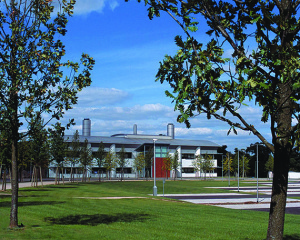 THE INVESTOR: BioMed Realty
THE INVESTOR: BioMed Realty
It’s not hard to spot the odd one out in BioMed Realty’s core target markets. While the US cities of San Diego, San Francisco and Cambridge, Massachusetts, sit in major urban areas and have many millions of square feet of commercial lab space, Cambridge, UK, is on a much smaller scale.
But for head of UK operations Doug Cuff, it fits perfectly. “From a population standpoint, Cambridge UK is much smaller but it’s growing at an incredible clip. It all starts with a solid university driving research and innovation and that is a magnet for talent. Around that, we see a clustering effect from companies that are interested in partnering with those institutions or in being around each other because that’s where the talent is. And wherever they’re going to be, we’re going to be.”
A specialist in facilities for life sciences companies, BioMed Realty is a REIT bringing a blaze of US “can-do” to the UK market. It arrived in 2012, with the purchase of Granta Park from MEPC for about £127m and, for now, its UK exposure is comparatively small – 470,000 sq ft of a portfolio that spans more than 18m sq ft. But it has just signed up US genomics giant Illumina for a new 155,000 sq ft headquarters on a 20-year lease from 2017. It has planning consent for a further 138,000 sq ft at Granta Park and Cuff is actively looking for other opportunities, including development.
“Anything that makes sense from a location standpoint, we will do,” Cuff says. “We are aggressively and actively pursuing as many opportunities as we can because we think it’s a phenomenal market. It’s the top cluster in all of Europe right now. We want to do more to bring more companies in and expand the existing clients as well.”
The Illumina deal is BioMed Realty’s preferred model, says Cuff, and it typically likes to have an anchor tenant in place for 50,000 or 100,000 sq ft, depending on the development. “But we are keeping our eye on the growing demand in Cambridge and will consider a speculative development if the market is there.”
Granta Park is unusual among BioMed’s investments in that it doesn’t have a mix of small and larger spaces, with start-ups alongside major players. “That’s very important because if the cutting-edge science that’s coming out of those labs doesn’t have the capital but it does have a mature company next door or an institution that it can collaborate with, that can help them through the process. It’s definitely something that developers should look at. Start-up companies don’t typically make money so you need a portfolio to offset that loss. But hopefully you grab one or two of those companies and they grow like crazy and it’s all worth it.”









